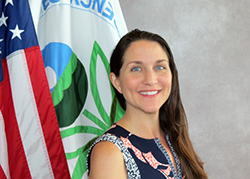NARPM Presents...Utilizations of the U.S. EPA - Environmental Response Team's Mobile Trace Atmospheric Gas Analyzer Laboratories to Address Environment Issues
Sponsored by: U.S. EPA Environmental Response Training Program (ERTP)
Archived: Thursday, August 30, 2018
NARPM Presents...Utilizations of the U.S. EPA - Environmental Response Team's Mobile Trace Atmospheric Gas Analyzer Laboratories to Address Environment Issues
2018-08-30
U.S. EPA Environmental Response Training Program (ERTP)
The U.S. EPA Environmental Response Team's (ERT) Trace Atmospheric Gas Analyzer (TAGA) mobile laboratories have been utilized for numerous and varied monitoring and analysis operations. Over the years, the TAGA laboratories have been employed at traditional emergency responses, including chemical plant explosions, train derailments, pipeline breaks, oil spills, floods, hurricanes, etc., as well as terrorist events involving the World Trade Center attack and the weaponized anthrax assaults of the United States Hart Senate Office Building, United State Post Offices, and the American Media Incorporated Building. Additionally, the TAGA laboratories have been used to perform ambient air monitoring in highly industrial areas of Texas and Louisiana as part of the US EPA's Urban Air Toxic Program. Moreover, the TAGA labs have been implemented to investigate vapor intrusion at over 100 Superfund sites across the country involving hundreds of buildings using the instrumentation to provide analytical results for soil gas, sub-slab vapor, indoor air, and ambient air matrices. Furthermore, the laboratories have been involved in research and development operations for chemical warfare agents' detection and remediation effectiveness of materials, as well as, fumigant detection and containment during building remediation of biological agents.
The TAGA mobile laboratories are currently comprised of analytical instrumentation, which includes but is not limited to a PE Sciex 365 triple quadrupole mass spectrometer (MS/MS) with a low pressure chemical ionization (LPCI) source and an atmospheric pressure chemical ionization (APCI) source, an Agilent Gas Chromatograph (GC) 7890 and Mass Spectrometer (MS) 5975C with a loop injection system, and an Agilent MicroGC. Additionally, the TAGA laboratories are equipped with a global positioning system (GPS) and a geographic information system (GIS). The stated equipment was incorporated to perform the above analytical services.
Accessibility, Recording, and Content Disclaimer
Rehabilitation Act Notice for Reasonable Accommodation
It is EPA's policy to make reasonable accommodation to persons with disabilities wishing to participate in the agency's programs and activities, pursuant to the Rehabilitation Act of 1973, 29 U.S.C. 791. Any request for accommodation should be made to Joey Gawarzewski at 302-283-2290 or Joseph.Gawarzewski@tetratech.com, preferably one week or more in advance of the webinar, so that EPA will have sufficient time to process the request. EPA would welcome specific recommendations from requestors specifying the nature or type of accommodation needed. Please note that CLU-IN provides both alternate phone call-in options and closed captioning for all webinars, and requests for these specific accommodations are not necessary.
Webinar Recording
By participating in this CLU-IN webinar, you automatically agree to authorize recording of audio and visual content presented during this live event and consent to subsequent use of this recording in the public domain by the U.S. Environmental Protection Agency. This recording may include questions, comments and poll responses provided by you during the live event in addition to your name, voice, image or likeness. This recording will be made available after the conclusion of the live event as part of the CLU-IN webinar archives, and will remain available indefinitely. If you do not wish to consent to the recording, please do not join the live event, and contact Jean Balent at 202-566-0832 or balent.jean@epa.gov to discuss your concerns.
Content Disclaimer
This webinar is intended solely to provide information to the public. The views and opinions expressed as part of this webinar do not necessarily state or reflect those of the U.S. Environmental Protection Agency. It is not intended, nor can it be relied upon, to create any rights enforceable by any party in litigation with the United States, or to endorse the use of products or services provided by specific vendors. With respect to this webinar, neither the United States Government nor any of their employees, makes any warranty, express or implied, including the warranties of merchantability and fitness for a particular purpose, or assumes any legal liability or responsibility for the accuracy, completeness, or usefulness of any information, apparatus, product, or process disclosed, or represents that its use would not infringe privately owned rights.
Presenter:
Dave Mickunas, U.S. EPA Environmental Response Team (mickunas.dave@epa.gov or 919-541-4191)
Mr. David Mickunas is a chemist for the U.S. Environmental Protection Agency’s Environmental Response Team (U.S. EPA/ERT). He has been performing trace gas analyses for over thirty-four years. He holds a chemistry degree from Grand Valley State University and a chemical engineering degree from the Missouri School of Science and Technology (formerly University of Missouri-Rolla).
For over three decades, he has been the lead for the advancement, development, and operation of the Trace Atmospheric Gas Analyzer (TAGA) mobile laboratories, which are outfitted with direct sampling triple quadrupole mass spectrometer, loop-injection gas chromatograph/mass spectrometer, and MicroGC instrumentation. He has extensive experience in monitoring, sampling, and analyzing outdoor ambient air, indoor air, and soil gas matrices.
Moderators:
 Jean Balent, U.S. EPA Technology Innovation and Field Services Division (balent.jean@epa.gov or 202-566-0832)
Jean Balent, U.S. EPA Technology Innovation and Field Services Division (balent.jean@epa.gov or 202-566-0832)
Ms Balent is on the staff of the EPA's Technology Innovation and Field Services Division where she has worked to collect and disseminate hazardous waste remediation and characterization information since 2003. Ms Balent manages the Clean Up Information Network website and actively supports online communication and collaboration resources available to EPA. She formerly worked with the US Army Corps of Engineers Environmental Engineering Division in the Buffalo District. Ms Balent was also a member of the SUNY-Buffalo Groundwater Research Group where she constructed and tested large scale models of groundwater flow. Ms Balent has also conducted research relating to the Great Lakes, environmental remediation, and brownfields re-development. She holds a Bachelor's degree in environmental engineering from SUNY-Buffalo and a Master's degree in Information Technology from AIU.
 Cindy Frickle, U.S. EPA Office of Superfund Remediation and Technology Innovation (frickle.cynthia@epa.gov or 202-566-0927)
Cindy Frickle, U.S. EPA Office of Superfund Remediation and Technology Innovation (frickle.cynthia@epa.gov or 202-566-0927)
Cindy Frickle is a physical scientist with EPA's Superfund program where she reviews and propagates technical information to site cleanup professionals through Clu-In, EPA forums, and interagency channels. Prior to joining EPA, she spent time characterizing contaminated sites, coring sediments, studying microbes, and teaching. She completed her Biogeology MS and Geology BS in the University of Minnesota's School of Earth Sciences.
Webinar Slides and References:
If you have a suggested topic or idea for a future CLU-IN internet seminar, please contact:
Technology Integration and Information Branch
PH: 202-566-0832 | Email: balent.jean@epa.gov
Technology Integration and Information Branch
PH: 202-566-0875 | Email: adam.michael@epa.gov





